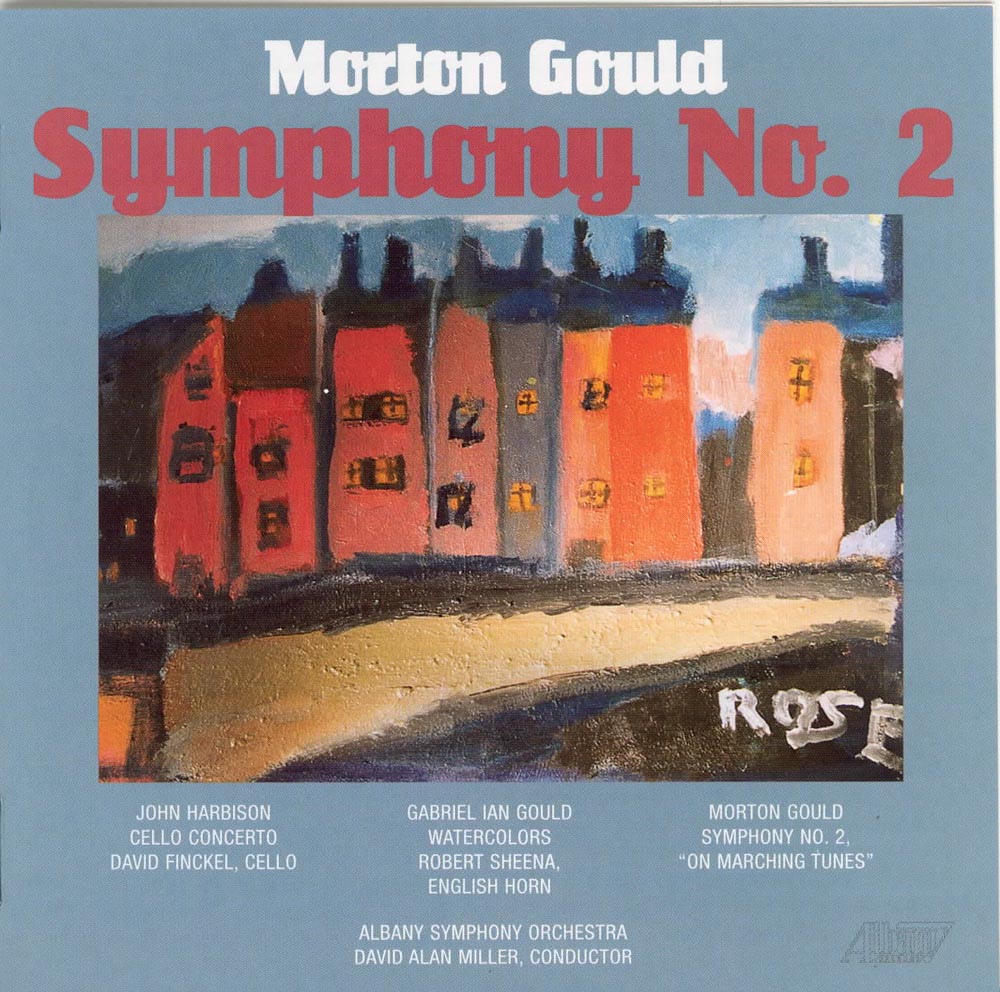Gould: Symphony No. 2
Robert Sheena (horn), David Finckel (cello), Albany Symphony Orchestra, David Alan Miller
Steven Stucky was half-finished with a brief work for large orchestra before deciding on the French term son et lumiere for his title. Meaning "sound and light," the coinage originated in Chambord in the early 1950s to refer to outdoor evening spectacles that featured brilliant lighting effects and recorded music as the background for talks about historical buildings. In Stucky"s resulting "orchestral entertainment whose subject is the play of colors, bright surfaces and shimmery textures," the composer explains that his aim was to "recapture the Tlan and immediacy that regular meters and repetitive rhythms make possible." Today, Stucky is professor of composition and director of the new music group, Ensemble X, at Cornell. A short, highly evocative - almost mystical - work for solo English horn and chamber orchestra, "Watercolors is not about the substance of water," says the composer Gabriel Ian Gould, "as much as it is about our perception of water. It also has very little to do with watercolor painting, as the title might suggest, although there is something in this piece of the technique's soft edges and blended colors. I have attempted to represent not water itself, but rather its fluid qualities of refraction and reflection, opacity and translucence, lightness, darkness and the myriad shades and tones in between." This work won Gould his second BMI Student Composer Award. John Harbison's Cello Concerto was commissioned by the Boston Symphony Orchestra and the Chicago Symphony Orchestra. Scored for large orchestra, it features an especially varied percussion section, with an array of pitched and unpitched gongs suggestive of the sort of East Asian ensemble called a gamelan. Dedicated to and premiered by cellist Yo-Yo Ma, it debuted in Boston on April 7, 1994, with Seiji Ozawa conducting the Boston Symphony Orchestra. These first performers, according to the composer, considerably determined the concerto's character and flavor. Harbison notes that the three connected movements "all move without warning between slow and fast, expressive and virtuosic, domestic and exotic. These moods are connected by the solo cello line, which rises from the East, eventually to descend, refracted, in the West." Almost joltingly catchy, straightforward and down-to-earth after the light sensitive works of this disc's other composers, Morton Gould's Symphony No. 2 (the handwritten score gives two subtitles: "On Marching Tunes" and "Symphony on Marching Tunes") was commissioned by the Young Men's Christian Association for its hundredth anniversary and dedicated to "the Freedom-loving Youth of the World." The premiere took place during a radio broadcast by the New York Philharmonic, under Vladimir Golschmann, on June 4, 1944. An anecdote, courtesy of Gould's biographer, Peter Goodman, attaches to that first (and apparently, before the Albany Symphony Orchestra's 1999 concert, the only) performance of the complete work: Golschmann had scheduled a rehearsal of the symphony the day before broadcast and asked Gould whether he planned to attend. The composer - known for his unrelenting work ethic - surprisingly said no, claiming some pressing engagement about whose nature he was surprisingly tight lipped. After the broadcast, Golschmann met the composer at the Russian Tea Room, where Gould introduced him to his companion, his wife Shirley. "I had no idea you were married!" the conductor said. "When was the wedding?" "Yesterday," said Gould. The timing of the premiere is also interesting on the level of global, not just intimate, affairs. Two days later, in the climactic military thrust of World War Two's European theater, Allied forces would invade Normandy. This led ultimately to victory, but victory built on a mound of many, many lives. The structuring of Gould's symphony may be reflective of the true cost of triumph.
Track Listing
| Title | Composer | Performer |
|---|---|---|
| Son et Lumière | Steven Stucky | Albany Symphony Orchestra, David Alan Miller, conductor |
| Watercolors | Gabriel Ian Gould | Albany Symphony Orchestra, David Alan Miller, conductor, Robert Sheena, English horn |
| Cello Concerto | John Harbison | Albany Symphony Orchestra, David Alan Miller, conductor, David Finckel, cello |
| Symphony No. 2 | Morton Gould | Albany Symphony Orchestra, David Alan Miller, conductor |
Reviews
- “
"...David Allen Miller leads expert performances, beautifully played...and vividly recorded....this is one of the most important discs of symphonic music to come along in quite some time."
- “
"These are beautifully detailed performances and recordings, with a nice attention to orchestral dynamics."
- “
"...an essential part of any collection of the American Symphony."
*Album cover provided for Editorial use only. ©Albany Records. The Albany Imprint is a registered trademark of PARMA Recordings LLC. The views and opinions expressed in this media are those of the artist and do not necessarily represent or reflect the views and opinions held by PARMA Recordings LLC and its label imprints, subsidiaries, and affiliates.

